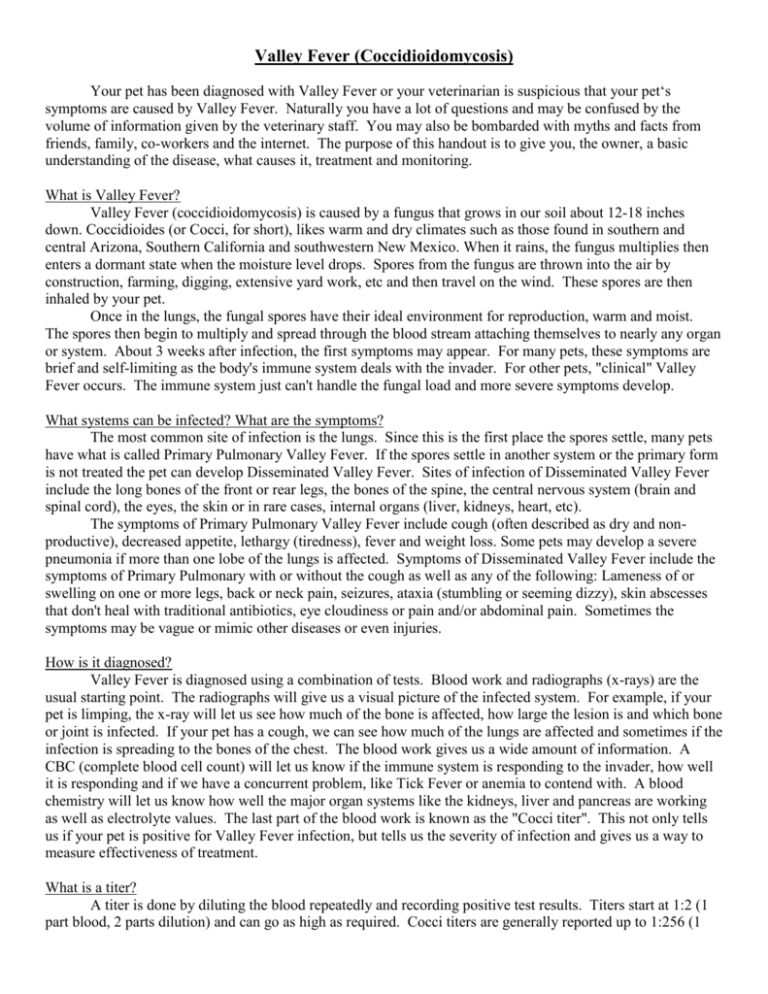Valley Fever (Coccidioidomycosis)
advertisement

Valley Fever (Coccidioidomycosis) Your pet has been diagnosed with Valley Fever or your veterinarian is suspicious that your pet‘s symptoms are caused by Valley Fever. Naturally you have a lot of questions and may be confused by the volume of information given by the veterinary staff. You may also be bombarded with myths and facts from friends, family, co-workers and the internet. The purpose of this handout is to give you, the owner, a basic understanding of the disease, what causes it, treatment and monitoring. What is Valley Fever? Valley Fever (coccidioidomycosis) is caused by a fungus that grows in our soil about 12-18 inches down. Coccidioides (or Cocci, for short), likes warm and dry climates such as those found in southern and central Arizona, Southern California and southwestern New Mexico. When it rains, the fungus multiplies then enters a dormant state when the moisture level drops. Spores from the fungus are thrown into the air by construction, farming, digging, extensive yard work, etc and then travel on the wind. These spores are then inhaled by your pet. Once in the lungs, the fungal spores have their ideal environment for reproduction, warm and moist. The spores then begin to multiply and spread through the blood stream attaching themselves to nearly any organ or system. About 3 weeks after infection, the first symptoms may appear. For many pets, these symptoms are brief and self-limiting as the body's immune system deals with the invader. For other pets, "clinical" Valley Fever occurs. The immune system just can't handle the fungal load and more severe symptoms develop. What systems can be infected? What are the symptoms? The most common site of infection is the lungs. Since this is the first place the spores settle, many pets have what is called Primary Pulmonary Valley Fever. If the spores settle in another system or the primary form is not treated the pet can develop Disseminated Valley Fever. Sites of infection of Disseminated Valley Fever include the long bones of the front or rear legs, the bones of the spine, the central nervous system (brain and spinal cord), the eyes, the skin or in rare cases, internal organs (liver, kidneys, heart, etc). The symptoms of Primary Pulmonary Valley Fever include cough (often described as dry and nonproductive), decreased appetite, lethargy (tiredness), fever and weight loss. Some pets may develop a severe pneumonia if more than one lobe of the lungs is affected. Symptoms of Disseminated Valley Fever include the symptoms of Primary Pulmonary with or without the cough as well as any of the following: Lameness of or swelling on one or more legs, back or neck pain, seizures, ataxia (stumbling or seeming dizzy), skin abscesses that don't heal with traditional antibiotics, eye cloudiness or pain and/or abdominal pain. Sometimes the symptoms may be vague or mimic other diseases or even injuries. How is it diagnosed? Valley Fever is diagnosed using a combination of tests. Blood work and radiographs (x-rays) are the usual starting point. The radiographs will give us a visual picture of the infected system. For example, if your pet is limping, the x-ray will let us see how much of the bone is affected, how large the lesion is and which bone or joint is infected. If your pet has a cough, we can see how much of the lungs are affected and sometimes if the infection is spreading to the bones of the chest. The blood work gives us a wide amount of information. A CBC (complete blood cell count) will let us know if the immune system is responding to the invader, how well it is responding and if we have a concurrent problem, like Tick Fever or anemia to contend with. A blood chemistry will let us know how well the major organ systems like the kidneys, liver and pancreas are working as well as electrolyte values. The last part of the blood work is known as the "Cocci titer". This not only tells us if your pet is positive for Valley Fever infection, but tells us the severity of infection and gives us a way to measure effectiveness of treatment. What is a titer? A titer is done by diluting the blood repeatedly and recording positive test results. Titers start at 1:2 (1 part blood, 2 parts dilution) and can go as high as required. Cocci titers are generally reported up to 1:256 (1 part blood, 256 parts dilutant). If at 1:256 your pet's blood is still positive it is reported as "greater than 1:256". The goal is to reduce the titer to "less than 1:2" or negative and have no symptoms. Unfortunately, the incubation period for Valley Fever is about 3 weeks. This means your pet may have all the symptoms of either Pulmonary or Disseminated Valley Fever, yet the first titer sent out may come back negative. Your veterinarian will want to repeat the Cocci Titer if traditional antibiotic therapy is not eliminating symptoms. In some cases, the pet will have a low or negative titer, yet have more severe symptoms than expected. This is often due to the pet’s immune system not responding as expected to the invader. If this is the case with your pet, your veterinarian will discuss with you a treatment plan specific for your pet. How do we treat Valley Fever? And how does the medication work? Valley fever is treated with a group of drugs called "antifungals" or "fungistatics". Unlike antibiotics we are familiar with, these drugs do not kill the fungal spore instead they slow or prevent the spores from reproducing or multiplying. By preventing reproduction, the medication allows the immune system to take care of the older spores. There are currently three oral forms of antifungals approved for veterinary use. Fluconazole (Diflucan) is the most commonly used as it has the lowest incidence of side effects. Ketoconazole and itraconazole are older medications that are sometimes used in pets who do not tolerate or are not responding to fluconazole. These two medications have a higher incidence of side effects and different monitoring requirements than fluconazole. If oral medications are not providing the treatment response expected, you and your pet may be referred to the Valley Fever specialist, Dr Lisa Shubitz at Veterinary Specialty Center of Tucson. All these medications are given in weight specific doses. The staff of Orange Grove Animal Hospital works with a number of compounding pharmacies in order to ensure the best price for your medication. If you have a pharmacy preference, please let us know. What monitoring does my pet need? For all pets, the current monitoring guidelines are: Every 3-6 months: -Recheck Cocci Titer. This involves a simple blood sample taken by the Orange Grove Animal Hospital technicians and sent to our outside lab. Results usually come back to the clinic within 3-5 days. -Repeat x-rays. If your pet has a bone or spinal lesion, you veterinarian may want to check the x-rays to see if the lesion is decreasing in size. Also if your pet had pneumonia your veterinarian will want to repeat the x-rays to ensure the lungs are healing. When the lab results come back, this is when your refill for medication will be called into the pharmacy. If your pet has gained weight, the dose may increase at this time. Additional monitoring: If your pet is older, is on other medications or has other diseases or conditions that are being treated, your veterinarian may recommend more extensive monitoring. Because fluconazole is mainly eliminated by the kidneys, your veterinarian may recommend monitoring kidney values, especially if your pet has diabetes or decrease kidney function. If your pet is on ketoconazole, itraconazole or a non-steroidal anti-inflammatory (Rimadyl, Metacam, DeraMaxx, etc), has decreased liver function or is older, your veterinarian may want to monitor liver enzyme values along with the kidney values. What are the side effects of the medication? Thankfully, fluconazole has fewer side effects than the older drugs like ketoconazole and itraconazole. A few pets may experience gastro-intestinal side effects such as nausea, vomiting, loss of appetite, diarrhea, or abdominal discomfort caused by GI upset (hunched up, reluctance to move or stretch, abdominal tenderness, restlessness). Giving the medication on a full stomach reduces the incidence of these symptoms. With ketoconazole, lightening of the coat color has also been seen. Itraconazole has been known to cause skin ulcerations. If you notice side-effects or your pet is not tolerating the medication, please let us know. Can I stop the medication if the symptoms go away? No! Even if your pet no longer has a cough or limp and seems back to normal, stopping or decreasing the medication without veterinarian approval can only increase length of treatment. In many cases, symptoms return fairly quickly with increased severity. Stopping or decreasing the medication can also cause Pulmonary Valley Fever to worsen to the Disseminated form. How long will my pet have to take the medication? That is very hard to predict. Each pet is different with different levels of disease and different immune responses. Length of treatment will depend on many factors: how high the initial titer is, the severity of clinical symptoms, the response to medication (how fast the titer goes down and symptoms resolve), if there is another concurrent disease such as Tick Fever or age-related conditions, how quickly treatment was started after symptoms appeared and of course, dedication of the owner. You will play a big role in determining the success of your pet’s treatment. It is important that you don’t skip or miss doses of medication, have your pet’s blood work checked on time (one to two weeks before finishing current prescription), and provide good nutritional support. Having said that, there are those pets that have to be on medication for life. Your veterinarian will discuss this possibility with you. What else can I do for my pet? Nutritional support is very important during any illness. We recommend feeding a high quality food such as Science Diet, Iams, Eukanuba, or Nutro. If your pet has lost a lot of weight or is slightly underweight, we may recommend returning to a high-quality puppy food for the initial few months of treatment. If your pet has stopped eating, we may recommend trying canned food that can be heated to encourage appetite. Occasionally, in very sick pets, we recommend feeding whatever your pet will eat, then switching over to a high-quality food once normal appetite has been established. In rare cases, we will go over detailed instructions on how to force feed your pet and which food to use. You can ask your veterinarian for recommendations regarding nutritional supplements. Is Valley Fever contagious? No! Valley Fever is contracted by the inhalation of the fungal spores. Your pet coughing is not spreading spores to you, your other pets or children. There is only one form of Valley Fever that carries a very tiny risk of contagion and thankfully it is very rare (your veterinarian can discuss this form with you). The reason we see some households with more than one pet with Valley Fever is that all the pets in the house have the same risk of infection. My pet's titer is negative, can he have a relapse? Why? Yes. According to the University of Arizona Valley Fever Center for Excellence, the relapse rate for people is between 30-50%. There hasn’t been a study to find out the exact percentage for pets, but it is suspected to be about the same as it is for people. The causes for relapse are varied and not well understood. If your pet has a return of symptoms or new symptoms, even after having a negative titer for months or years, see your veterinarian as soon as possible. Where can I get more information on Valley Fever? The best place to start is the University of Arizona’s Valley Fever Center for Excellence. There website address is http://www.vfce.arizona.edu/index.htm. Your veterinarian can also direct you to other reliable places for information. Remember to take any information gathered from a non-university or non-veterinary source with a huge grain of salt. As always, the staff at Orange Grove Animal Hospital is here to offer support and information during the course of your pet’s treatment. You are welcome to call with questions at any time during business hours. A technician will return your call as soon as possible and will be happy to answer your questions. © ORANGE GROVE ANIMAL HOSPITAL, SVG, PC 2014





